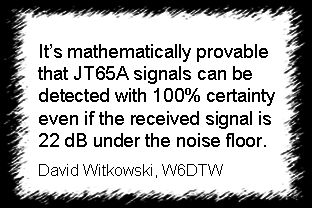JT65A is excellent for QRP |
This page describes my operation on HF using the protocol JT65A.
 | ||||||||||||||||||||||||||||||||||||||||||||||||
| Why JT65A? The reason for beginning experiments with JT65A is mainly, that I've had good results with WSPR. My 5 W WSPR signal reached all continents using a horizontal loop antenna. But WSPR is a one-way protocol, and spots received from DX stations do not count as QSOs. The WSPR spot merely tells me, that a station heard me and reported my signal on the internet. As JT65A belongs to the same protocol family as WSPR, I hope to reach distant places with JT65A and obtain real QSOs. Equipment My HF-transceiver is a Kenwood TS-850. Power is reduced to 25 W output or lower. The transceiver is connected to the PC with a homemade interface carrying audio and PTT. The antenna is a horizontal wire loop 43 meters long. It hangs between trees in the garden. A surprising start I downloaded JT65-HF (a freeware package developed by W6CQZ) from the homepage of IZ4CZL. I installed the software and typed in my call, locator, and input/output sound devices. I saved the settings and connected the PC-interface. My Win7 PC clock was synchronized by the Meinberg method (Meinberg versus Dimension 4 is discussed here). The radio was tuned to 14076 kHz USB.  The first JT65A station heard was OH7FMT about 1500 km away. OH7FMT from Finland appeared on the screen (see the screen-dump above). And much to my surprise, there was no antenna connected. No antenna at all, just the empty antenna socket. The signal was weak (-26 dB) but readable. Quickly, I connected 3 meters of wire to the antenna socket. OH7FMT called again, and this time his signal was stronger: -8 dB. Wow, what a surprise! No antenna, and the first station already heard! This looked promising. Using the short wire antenna, I heard several other European stations that Saturday afternoon. Four days later, I left my radio open (14076 kHz) while going to work. I used the same antenna as earlier: 3 meters of wire. At the end of the day, I discovered in the decode window which stations were received. Again, JT65A had some nice surprises for me. Stations from 3 continents were received: Europe (many stations), Africa (EA8TJ, distance 3700 km) and Asia (UA0WFG, distance 5000 km). Amazing when you consider my rudimentary antenna - just a short piece of wire. 8 days later JT65A is an efficient communication protocol and it is possible to work the world with it. My transceiver puts out 25 W and is connected to a horizontal loop antenna. I am happy to report, that my signal can reach all continents. The table below lists all stations I worked during the first 8 days of activity. There are even two new DXCC entities among them: Gabon and Zambia.
2 weeks later I continued to operate JT65A the next two weeks. I chased new zones, or zones where a confirmation (QSL) was missing. As shown in the table below, two new zones were worked, and two zones missing QSL were worked again. I am pleased with the results and a complete WAZ is now in sight.
Many other DX stations were worked during the two weeks: EA8 (Canary Islands), ZS (South Africa), UN (Kazakhstan), JA (Japan), PY (Brazil), LU (Argentina), and K (USA). The JT65A QSO The standard JT65A QSO is a minimal contact and it only contains the necessary information. JT65A was not created with chatting in mind. The table below shows how a standard JT65A QSO is performed. All data stems from my QSO with JA5PJ on 21.076 Mhz. Call signs and signal reports are automatically added to the message by the JT65-HF software. | ||||||||||||||||||||||||||||||||||||||||||||||||
| Time Message Description 07:58 CQ JA5PJ PM74 JA5PJ calls CQ 07:59 JA5PJ OZ1BXM JO46 OZ1BXM answers JA5PJ 08:00 OZ1BXM JA5PJ -22 JA5PJ sends my signal report (-22) 08:01 JA5PJ OZ1BXM R-13 OZ1BXM acknowledge signal report (R) and sends JA5PJ's signal report (-13) 08:02 OZ1BXM JA5PJ RRR JA5PJ acknowledge by 3 times R that everything has been received 08:03 JA5PR OZ1BXM 73 OZ1BXM ends the QSO by sending 73 to JA5PJ 08:04 OZ1BXM JA5PJ 73 JA5PJ sends 73 to OZ1BXM |
Written by OZ1BXM Lars Petersen, latest revision 08-Sept-2012.
